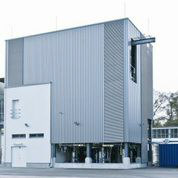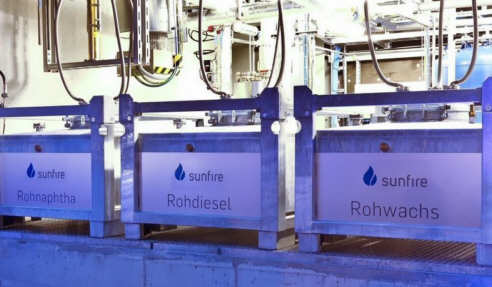|
SUNFIRE presents Power-to-Liquids
PtL rig uses
renewable electricity to convert water and CO2 to high-purity alternative
fuels (petrol, diesel, kerosene)
2014 Nov 14 + + + A Power-to-Liquids (PtL) demonstration rig which is
the first of its kind in the world was today officially inaugurated by
Dresden-based sunfire GmbH in the presence of Federal Minister of
Education and Research Johanna Wanka, Bilfinger Board Member Pieter Koolen
and a number of other high-ranking representatives from the worlds of
politics, industry and research.
 The
rig uses sunfire’s PtL technology to transform water and CO2 to
high-purity synthetic fuels (petrol, diesel, kerosene) with the aid of
renewable electricity. So-called PtL fuels – also known as “e-fuels” – can
be used in pure form or as an admixture in combination with conventional
fuels, and are recognized as an environmentally friendly, resource-saving
alternative which contributes to the fulfilment of greenhouse gas quotas.
Preparations for the commissioning of the PtL rig are currently in fully
swing at sunfire’s Gasanstaltstraße premises. The
rig uses sunfire’s PtL technology to transform water and CO2 to
high-purity synthetic fuels (petrol, diesel, kerosene) with the aid of
renewable electricity. So-called PtL fuels – also known as “e-fuels” – can
be used in pure form or as an admixture in combination with conventional
fuels, and are recognized as an environmentally friendly, resource-saving
alternative which contributes to the fulfilment of greenhouse gas quotas.
Preparations for the commissioning of the PtL rig are currently in fully
swing at sunfire’s Gasanstaltstraße premises.
High-temperature steam electrolysis
The PtL technology is built around the solid oxide electrolysis cells
(SOECs) developed by the cleantech firm as part of the eponymous BMBF
research project SUNFIRE. Step 1 of the PtL process sees the SOECs used to
convert electrical energy to chemical energy. Hydrogen is generated using
steam rather than liquid water.
Step 2 – the reverse water-gas
shift reaction – is again innovative, and involves the use of the hydrogen
(H2) yielded by the steam electrolysis step to reduce carbon dioxide (CO2)
to carbon monoxide (CO) for the third and final step: Fischer-Tropsch
Synthesis. This step sees the carbon monoxide and additional hydrogen (in
the form of renewable synthesis gas) converted to petrol, diesel, kerosene
and other base products for the chemicals industry (e.g. waxes). The
feeding of the heat released during synthesis back
into the process
ensures a high degree of system efficiency (70 per cent).
Proof of
technical feasibility at industrial scale
The cost of building the PtL demonstration rig was within the seven-digit
range, with development costs also incurred at the various consortium
members. Half of the overall sum invested corresponds with the public
funding received from the Federal Ministry of Education and Research. The
rig’s capacity for CO2 recycling stands at 3.2 tonnes per day, and once
brought into commission it will produce up to a barrel of fuel per day.
Commercialization is dependent on further technological development and
regulatory factors
and scheduled for 2016.
Source: Nils Aldag,
Martin Jendrischik, sunfire GmbH
www.sunfire.de
|

Worldwide more than
90,000 paid subscriptions

Worldwide
more than 48,000 subscriptions -
100% one-year direct request
qualification

'What's New' in Upstream, Midstream and
Downstream Products & Services. Circulation 37,000
PennWell
Petroleum Group:
Oil & Gas Journal
Oil & Gas Journal Russia
OGJ_eNewsletter
OGJ-Website-Statistics
Oil, Gas & Petrochem Equipment
Offshore Magazine
Offshore
Russia
Offshore eNewsletter
Offshore
Website Statistics
Oil & Gas Financial Journal
+ + +
For more information, media
kits or
sample copies please contact
Andreas
Sicking
+49 (0)2903-338570
wilhelms@pennwell.com
www.sicking.de
|

 The
rig uses sunfire’s PtL technology to transform water and CO2 to
high-purity synthetic fuels (petrol, diesel, kerosene) with the aid of
renewable electricity. So-called PtL fuels – also known as “e-fuels” – can
be used in pure form or as an admixture in combination with conventional
fuels, and are recognized as an environmentally friendly, resource-saving
alternative which contributes to the fulfilment of greenhouse gas quotas.
Preparations for the commissioning of the PtL rig are currently in fully
swing at sunfire’s Gasanstaltstraße premises.
The
rig uses sunfire’s PtL technology to transform water and CO2 to
high-purity synthetic fuels (petrol, diesel, kerosene) with the aid of
renewable electricity. So-called PtL fuels – also known as “e-fuels” – can
be used in pure form or as an admixture in combination with conventional
fuels, and are recognized as an environmentally friendly, resource-saving
alternative which contributes to the fulfilment of greenhouse gas quotas.
Preparations for the commissioning of the PtL rig are currently in fully
swing at sunfire’s Gasanstaltstraße premises.
